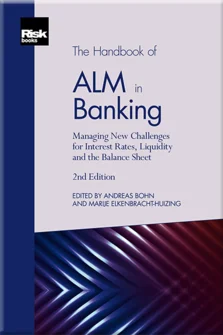A Global Perspective on Stress Testing
Bernhard Kronfellner, Stephan Süß and Volker Vonhoff
Introduction
Bank Capital and Liquidity
ALM in the Context of Enterprise Risk Management
The New Basel Standards on IRRBB and Their Implications for ALM
Measuring and Managing Interest Rate and Basis Risk
The Modelling of Non-Maturity Deposits
Modelling Non-Maturing Deposits with Stochastic Interest Rates and Credit Spreads
Managing Interest Rate Risk for Non-Maturity Deposits
Replication of Non-Maturing Products in a Low Interest Rate Environment
Managing Mortgage Prepayment Risk on the Balance Sheet
Considerations for ALM in Low and Negative Interest Rate Environments
Credit Spreads
Hedge Accounting
Supervisory Views on Liquidity Regulation, Supervision and Management
Measuring and Managing Liquidity and Funding Risk
Managing Reserve Assets
Instruments for Secured Funding
Asset Encumbrance
Capital Management
A Global Perspective on Stress Testing
Reverse Stress Testing: Linking Risks, Earnings, Capital and Liquidity – A Process-Orientated Framework and Its Application to Asset–Liability Management
XVAs and the Holistic Management of Financial Resources
Optimal Funding Tenors
Funds Transfer Pricing in the New Normal
Balance-Sheet Management with Regulatory Constraints
Since the 1990s, bank risk managers and regulators have become increasingly aware of the need to conduct stress tests on banks’ balance sheets to assess the resilience of single banks (commonly referred to as “microprudential stress tests”), as well as the financial sector as a whole (widely known as “macroprudential stress tests”). In general, stress testing is a simulation technique to quantify the impact of (mostly) adverse market conditions on a financial portfolio. Likely outcomes are evaluated for historical and/or plausible but severe hypothetical stress scenarios. As such, these are easy to understand and communicate to board members and senior management, stakeholders and regulators.
In this chapter, we provide a short summary of stress testing history, discuss the details of major stress testing frameworks and give guidelines for a stress testing programme setup. For brevity, we restrict the scope of our analysis mainly to the US, eurozone and the UK. In addition, we outline likely future developments in stress testing design and methodology and their applications for internal bank steering.
Stress testing in the banking industry before the 2007–9 financial crisis
Copyright Infopro Digital Limited. All rights reserved.
As outlined in our terms and conditions, https://www.infopro-digital.com/terms-and-conditions/subscriptions/ (point 2.4), printing is limited to a single copy.
If you would like to purchase additional rights please email info@risk.net
Copyright Infopro Digital Limited. All rights reserved.
You may share this content using our article tools. As outlined in our terms and conditions, https://www.infopro-digital.com/terms-and-conditions/subscriptions/ (clause 2.4), an Authorised User may only make one copy of the materials for their own personal use. You must also comply with the restrictions in clause 2.5.
If you would like to purchase additional rights please email info@risk.net











